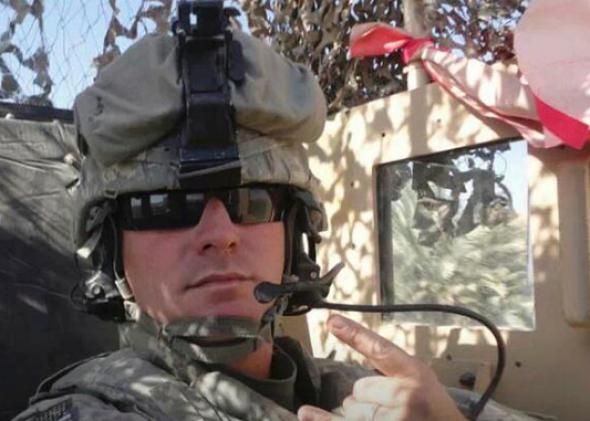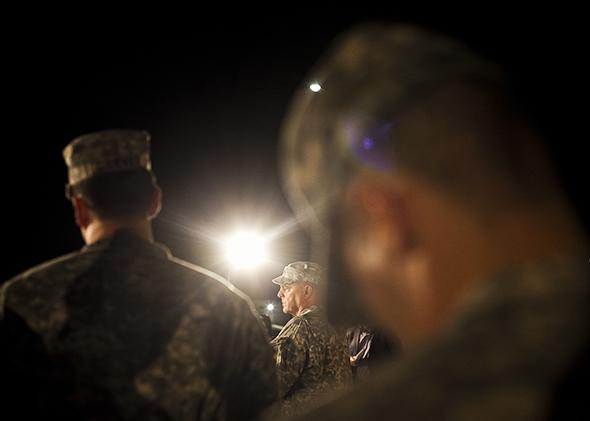How Can Anger And Revenge Lead To Fights
How to Stop Violence
Mentally ill people aren't killers. Angry people are.

Photo past Puerto Rico National Guard via Reuters
The deadly shooting in Parkland, Florida, has reignited the debate about the mental health of mass shooters and whether treating mental affliction could reduce the expiry toll wrought by gun violence. In 2014, psychologist Laura L. Hayes wrote virtually the relatively weak connection between mental illness and mass shootings and the much stronger connexion betwixt the inability to manage anger and violence. Her points are just as relevant today.
In the 1980s, around the time of the massive deinstitutionalization of the mentally ill, I was working toward my degree in clinical psychology by grooming at a psychiatric hospital in Washington, D.C. One sweet, diminutive, elderly patient sometimes wandered the halls. She had been committed to the hospital after she stabbed someone in a supermarket. She was what is sometimes referred to as a revolving-door patient: She was schizophrenic and heard frightening voices in her caput, and when she became psychotic enough, she would be hospitalized, stabilized on medication, and then released back to the community. In that location she would soon go off her medication, become psychotic, exist rehospitalized, stabilized once more on medication, released, etc.
At her commitment hearing, she testified that she had get extremely upset in the grocery store earlier repeatedly stabbing the homo in front of her in the checkout line. The hearing officer, aware of her history and sympathetic to this woman with such a sugariness demeanor, asked helpfully if she had been hearing voices at the time. Yes, she replied, she had. "And what were the voices telling yous?" the officer inquired supportively. She explained that the voices were telling her non to hurt the man, simply he had gotten in the express checkout lane with more than 10 items, and that made her so mad that she couldn't stop herself.
In addition to being a valuable cautionary tale about grocery etiquette, the story illustrates an important truth almost violence and mental health: Violence is not a product of mental illness; violence is a product of anger. When we cannot modulate anger, it volition control our behavior.
In the wake of a string of horrific mass shootings by people who in many cases had emotional bug, it has go fashionable to blame mental illness for violent crimes. It has even been suggested that these crimes justify not only banning people with a history of mental illness from buying weapons simply as well arming those without such diagnoses then that they may protect themselves from the dangerous mentally ill. This fundamentally misrepresents where the danger lies.
Violence is not a product of mental illness. Nor is violence generally the action of ordinary, stable individuals who suddenly "break" and commit crimes of passion. Vehement crimes are committed by violent people, those who do not have the skills to manage their anger. Most homicides are committed by people with a history of violence. Murderers are rarely ordinary, law-abiding citizens, and they are besides rarely mentally sick. Violence is a production of compromised anger management skills.
In a summary of studies on murder and prior tape of violence, Don Kates and Gary Mauser found that eighty to xc percent of murderers had prior police force records, in contrast to fifteen percent of American adults overall. In a report of domestic murderers, 46 percent of the perpetrators had had a restraining order confronting them at some fourth dimension. Family murders are preceded by prior domestic violence more than xc percent of the time. Violent crimes are committed by people who lack the skills to modulate anger, express it constructively, and move across it.
The Diagnostic and Statistical Transmission of Mental Disorders, Fifth Edition, the reference book used by mental wellness professionals to assign diagnoses of mental illness, does very piddling to address anger. The one relevant diagnosis is intermittent explosive disorder, a disorder of acrimony management. People with IED tend to come from backgrounds in which they have been exposed to patterns of IED behavior, oft from parents whose ain anger is out of control. Merely the DSM does not provide a diagnostic category helpful for explaining how someone tin can, with careful advance planning, come to enter an uncomplicated schoolhouse, nursing dwelling house, theater, or authorities facility and indiscriminately begin to kill.

Photo by Drew Anthony Smith/Getty Images
Violent crimes committed by people with astringent mental illnesses become a lot of attention, only such attacks are relatively rare. Paolo del Vecchio of the federal Substance Abuse and Mental Health Services Administration has said, "Violence by those with mental illness is so small that even if yous could somehow cure it all, 95 percentage of fierce criminal offence would withal exist." A 2009 study by Seena Fazel found a slightly higher charge per unit of violent crime in schizophrenics—but it was near entirely accounted for by alcohol and drug abuse. Likewise, the MacArthur Violence Gamble Assessment Study found that mentally ill people who did non have a substance abuse problem were no more vehement than other people in their neighborhoods.
With no clear explanation of the causes of violent crime from the mental health field, and with meaning encouragement from the gun lobby, the public has begun to seize on the wrong caption for tragic, fierce events. They focus not on the IED-diagnosed patients but on those with other diagnoses, schizophrenia in particular, ignoring the fact that what the perpetrators have in common in every single i of these cases is a loss of control of their anger.
The attribution of violent offense to people diagnosed with mental illness is increasing stigmatization of the mentally ill while virtually no effort is being fabricated to address the much broader cultural problem of anger management. This broader problem encompasses non only mass murders but violence toward children and spouses, rape, road rage, assault, and violent robberies. We are a culture awash in anger.
Anger disorders are a product of long-term acrimony mismanagement. They are a pathological misdirection of normal aggressive feelings. Anger is, at its essence, a role of the bones biological reaction to danger, the fight or flight response. The physiological shift makes the states stop thinking and mobilize for immediate action, as though our life depends on information technology. Information technology is a primitive response, and very powerful. Anger prepares usa to stand our ground and fight. It helped our ancestors survive, but in today's complex technological world, it is frequently more hindrance than help. The angrier yous feel, the less clearly you can think, and therefore the less able y'all are to negotiate, take a new perspective, or effectively handle a provocation.
The violence that is a role of anger disorders is fueled by chronic repressed rage that has found no socially adequate outlet. It is fostered past families in which adults comport in violent, intimidating ways or in which acrimony is tightly repressed. In either situation there is no appropriate model for the safe or constructive expression of anger.
One of the allegations that take recently been made is that the mental health community is failing lodge in dealing with violent criminal offense. I would agree with this assessment. We have failed to provide an advisable diagnosis for out-of-control acrimony or a framework to assist people in understanding the senseless violence around them, and worse, we have done goose egg to prevent information technology.
The truth is, acrimony management skills are unproblematic techniques that can and should be taught to children and adolescents. We should non await to teach these skills until verbally or physically vehement behavior has get habitual and, oftentimes, life-threatening.
The skills involve balancing the initial fight-or-flying response, governed past the sympathetic nervous system, with its opposite, the parasympathetic nervous system, which permits reasoning to take over over again. Information technology's simple, only it requires a significant amount of practise. In that location are many techniques that can be taught to achieve this end: deliberate shifting from emotional to more objective thinking, deep breathing and other relaxation techniques, communication and listening skills, and identifying warning cues before anger boils over.
Mindfulness training is a technique that shows swell hope as a tool for the development of healthy and constructive direction of negative emotions. Mindfulness can reduce anxiety, depression, and stress. It has been used with success in populations every bit diverse every bit cardiac patients, prison inmates, police officers, and children. It incorporates deep breathing, heightened attention to ane's internal state, and the acceptance of internal discomfort. 1 can observe one's own thoughts without identifying with them and interim on them.
Dialectical behavior therapy, a kind of cognitive therapy developed past the psychologist Marsha Linehan, was designed to come across the needs of extremely emotional, volatile individuals and has been used successfully over the past 25 years. It incorporates mindfulness skills and besides teaches distress tolerance, emotional regulation, and interpersonal effectiveness.
Uncontrolled acrimony has become our No. 1 mental health issue. Though we have the understanding and the skills to treat the anger epidemic in this country, as a culture, we accept been unwilling to take the violence problem every bit one that belongs to each and every one of the states. We take sought scapegoats in minority cultures, racial groups, and now the mentally ill. When we are ready to accept that the demon is within us all, we can brainstorm to treat the bicycle of anger and suffering.
Source: https://slate.com/technology/2014/04/anger-causes-violence-treat-it-rather-than-mental-illness-to-stop-mass-murder.html

0 Response to "How Can Anger And Revenge Lead To Fights"
Post a Comment